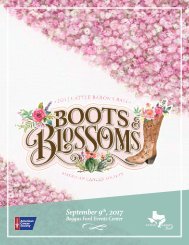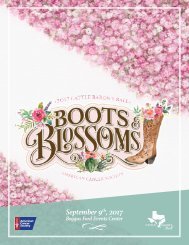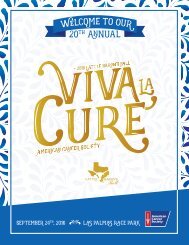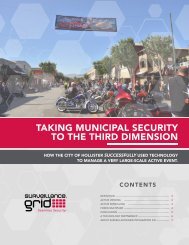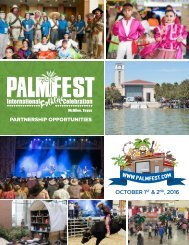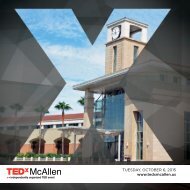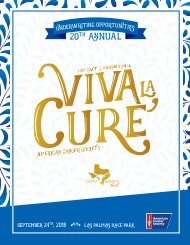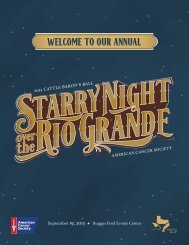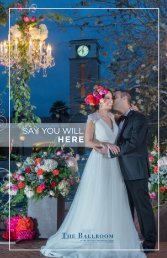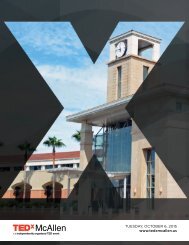Valley Symphony Orchestra Education Concert Booklet
Create successful ePaper yourself
Turn your PDF publications into a flip-book with our unique Google optimized e-Paper software.
20
20 education
concert
20 education
20concert
We are looking forward to having you at the VSO’s Education Concerts and cannot wait to share this wonderful
music with you. In this document you will find information and resources relating to the music your students will
be hearing. There are also links to recordings of each piece should you want your class to listen to examples of the
music. Use some or all of these resources to best prepare your class for an exciting Education Concert!
Terms to review
BEFORE PROCEEDING
MAESTRO:
CONCERTMASTER:
SYMPHONY ORCHESTRA:
MOVEMENT:
The conductor of the orchestra.
The first chair violinist and instrumental leader of the orchestra.
A group of instruments traditionally consisting of violin, viola, cello,
bass, flute, oboe, clarinet, bassoon, french horn, trumpet, trombone,
tuba, and percussion.
A self-contained part of a larger work, similar to a chapter within a
book.
What you will see before the performance begins
• Musicians will be on stage warming up.
• The Concertmaster will walk out, the
orchestra will grow silent, and the
audience (that’s you!) will clap.
• The Concertmaster will direct the oboe
player to play a note for the orchestra
to match. This is called the tuning note.
Multiple tuning notes will be played, one
each for woodwinds, brass, and strings.
• After the tuning note, the concertmaster
will sit down and everyone, including the
audience, will stay quiet.
• The Maestro will walk out on stage, the
orchestra will stand, and the audience
will clap.
• Sometimes the Maestro will speak to the
audience, sometimes the Maestro will
start the music right away. Regardless,
this is when the audience starts listening.
Audience Member Expectations
• Stay seated throughout the performance
• Clap at the end of each piece (it is polite
and shows you enjoyed the music!)
• Save talking for after the performance
• Make sure your cell phone is turned off
How to Stay Engaged with the Music
• See if you can tell which musicians are
playing and which musicians are resting.
• Do you recognize the instruments in the
orchestra?
• How are the conductor’s movements
reflecting the music?
• See if you can tap the steady beat on your
leg with the tip of your finger.
Pyotr Ilyich
Tchaikovsky
(1840-1893)
THE NUTCRACKER SUITE, MARCH (1892)
geography
Tchaikovsky was a Russian composer.
He was born in the city of Votkinsk, which is
6,457 miles away from McAllen, Texas!
history
This ballet was adapted from a story by E.T.A. Hoffman
called The Nutcracker and the Mouse King. Ivan
Vsevolozhsky, the director of the Imperial Theatres,
commissioned Tchaikovsky to write the music for this
ballet. Here is a synopsis of The Nutcracker Ballet story.
While this music was intended to be performed as a ballet
with dancers, Tchaikovsky also took selected music from
the ballet and created a suite to be performed only by
orchestra.
Music
A march is a genre of music with a strong, steady beat
that is typically performed by a military band. The U.S.
Army Old Guard Fife and Drum Corps performs music
from around the time of the American Revolution using
instruments and uniforms that would have been found in
that time. Nutcracker dolls were frequently decorated as
soldiers, which is why they are accompanied by militaristic
music.
instruments
Trumpets have a history within many countries’ military, which is why they are
featured in this movement. They are playing staccato, which is when the notes are
short and separated.
vocabulary
What is a Nutcracker?
Besides cracking the shells
of nuts, a nutcracker doll
symbolizes good luck. Within
German folklore they are said to
be protectors of the house. Maybe
that is why the Nutcracker is the one
who saves Marie from the Mouse King.
dance
Ballet is a concert dance that has
a rich history in Russian culture.
Ballerinas typically dance ‘en pointe,’
which is on the tip of their toes. You
may not be able to dance on point, but
you can march along to the beat of the
music!
Would you like to learn more about Tchaikovsky?
Click here for a Classics for Kids composer profile which includes other examples of his music.
Franz
Liszt
(1811-1886)
PIANO CONCERTO NO. 1, EB MAJOR,
MOVEMENT I (1830-1856)
geography
Liszt was a Hungarian composer, but he spent a lot of his life in
Germany.
Check out the map of mainland Europe and see if you can find
Hungary and Germany.
history
This piece was written over a period of 26 years!
Music
A concerto is an instrumental solo that is accompanied by
an orchestra. The solo instrument within this piece is the
piano, which is why it is has the most prominent musical
passages. Frequently, the orchestra and soloist trade off.
The soloist will sometimes play by themselves and it will
be hard to feel a steady beat. This is called a cadenza and is
usually an opportunity for the soloist to show off.
instruments
The piano is a member of the string family.
Inside there are steel strings that are
struck by a small hammer when a key is
pressed. Because the strings are struck,
you could also argue that the piano is a percussion
instrument. There are upright pianos (L) and
grand pianos (R).
language
The native language of Hungary is Hungarian, but Liszt
spoke German, too. He created funny, unofficial lyrics for
this movement in German. The very first thing you hear is
said to have been Liszt mocking his critics! Das versteht ihr
alle nicht, haha! (translation: none of you understand this,
ha-ha!) This motive returns again and again throughout the
movement. The instruments that play the “ha-ha!” change
as the movement progresses. You can hear this at the very
beginning with the woodwind instruments playing the “haha.”
In the middle of the movement,
there is a duet between the
piano and clarinet. The clarinet is a member of the
woodwind family and was developed differently
by German and French musicians. On the left
is a French-keyed clarinet and on the right is
a German-keyed clarinet. All of the clarinet
players in the VSO play on French-system
clarinets.
Click here for other information and activities involving music by Liszt.
Johannes
Brahms
(1833-1897)
HUNGARIAN DANCE NO. 6, D MAJOR
(1858-68)
geography
Brahms was a composer who was born in Hamburg, Germany
(yes, that’s where we get the name Hamburger), but he spent
most of his life living in Vienna, Austria. This was not uncommon
as Vienna was “The Place” for music, similar to how an actor
might originally be from Texas but move to Hollywood because
it’s the center of the entertainment industry.
history
Brahms wrote many Hungarian Dances (21!), but did not
travel to Hungary to compose them. Instead he wrote
them based on melodies he heard from traveling Roma
musicians (formerly known as Gypsies.)
Music
This piece is in Ternary Form. The first section is the
same as the third section. The second section has two
new melodies that are introduced. The melody is slower
and heavier with the violins playing the melody. Can you
hear the three sections? You know the third section has
started when it sounds like the piece has started back at
the beginning.
dance
Some of the Hungarian Dances Brahms wrote were based
on Csárdás, a folk dance from Hungary. It is characterized
by a variation in tempo (speed) and sometimes starts out
slowly and then gradually speeds up. Do you know a dance
that does this?
instruments
Originally written for four hands (two people
playing piano), you will hear this piece performed
by a symphony orchestra. When you take music
written for piano, or another instrument, and
rewrite it for orchestra, it is called orchestration.
Listen to what the four hands version sounds
like! How do they sound different?
via DSO Kids
Click here for more information about Brahms from DSO Kids!
Leroy
Anderson
(1908-1975)
BUGLER’S HOLIDAY (1954)
geography
Anderson was born in Cambridge,
Massachusetts, which is 2,193 miles away from
McAllen!
history
Anderson was a member of the Army and was stationed at
the Pentagon in 1945, but he still composed music while
there. His pieces were very popular while he was still alive,
which was not the case with a lot of composers.
Music
A holiday is another word for a vacation. This music
imagines the fun that buglers have when they are not on
active military duty. How is this music different from the
militaristic trumpeting in The Nutcracker March?
instruments
A bugle is similar to a trumpet, but does not have any valves (buttons.)
Early bugles were made out of animal horns. Traditionally, bugles have
been used in the military to help officers communicate with their
soldiers during battle before the invention of radios.
If you enjoy Bugler’s Holiday, you are sure to love Anderson’s other works, some of which
feature a typewriter and a “clock” as instruments!
Arturo
Marquez
(b. 1950)
CONGA DEL FUEGO NUEVO (2001)
geography
Marquez is a Mexican composer born in Alamos,
Sonora and currently lives in Mexico City. Mexico
City is very close to us compared to where the
other composers are from!
history
Marquez was the son of a mariachi musician and his
grandfather was a Mexican folk musician in Sonora and
Chihuahua, Mexico. He began his musical training by
playing in a mariachi ensemble. In 2006, Marquez was the
first musician to ever win La Medalla De Oro De Bellas Artes
de Mexico (Gold Medal of Fine Arts of Mexico.)
Music
In this piece, the claves (pictured below) are playing the
‘son clave’ rhythm which is the most common way this
instrument is played within Latin music. The claves are a
high-pitched percussion instrument made out of wood.
instruments
Conga drum:
An afro-cuban drum that is tubular and tapered toward the bottom.
It is usually played with the hands. Click the link to see an example of
conga playing!
dance
The Conga is Cuban, but has roots in African dance.
Check out this video of a Cuban dance company for an
example of what a Conga dance can look like. You can
certainly hear the conga drum in this recording!
20 education
20concert
Suggested Activities [approx. grade levels noted]
• Figure out what direction you would need to go to get from the
composer’s birth place to where they spent most of their lives. [3-
5]
• Find the steady beat of the music and tap your foot to the beat.
Does it speed up or slow down? Is it easy or difficult to find? [K-5]
• When listening to The Nutcracker March and Bugler’s Holiday, try
marching to the beat. [K-5]
• Listen for a specific instrument within each piece. For instance,
raise your hand when you hear the clarinet in the Liszt. [K-5]
• Clap along with the son clave rhythm in the Marquez [6-8]
• Explore different instruments and what vibrates on each
instrument to produce sound. [K-5]
• Discuss why bigger instruments sound lower and smaller
instruments sound higher. Order the instruments of the orchestra
from lowest-sounding to highest-sounding. [K-5]
• What happens to the vibrations to make the instrument play
softer/louder or higher/lower? [6-8]
• Discuss the materials used to make each instrument. How does the
material affect the sound of the instrument? [6-8]
• What was happening in the United States when Anderson was
writing Bugler’s Holiday? [6-8]
20 education
20concert
The 2020 Children’s Education Concerts
are presented with generous sponsorship from:
Concert Guide Author: Meredith Gersten
Design: Black Koi 360





